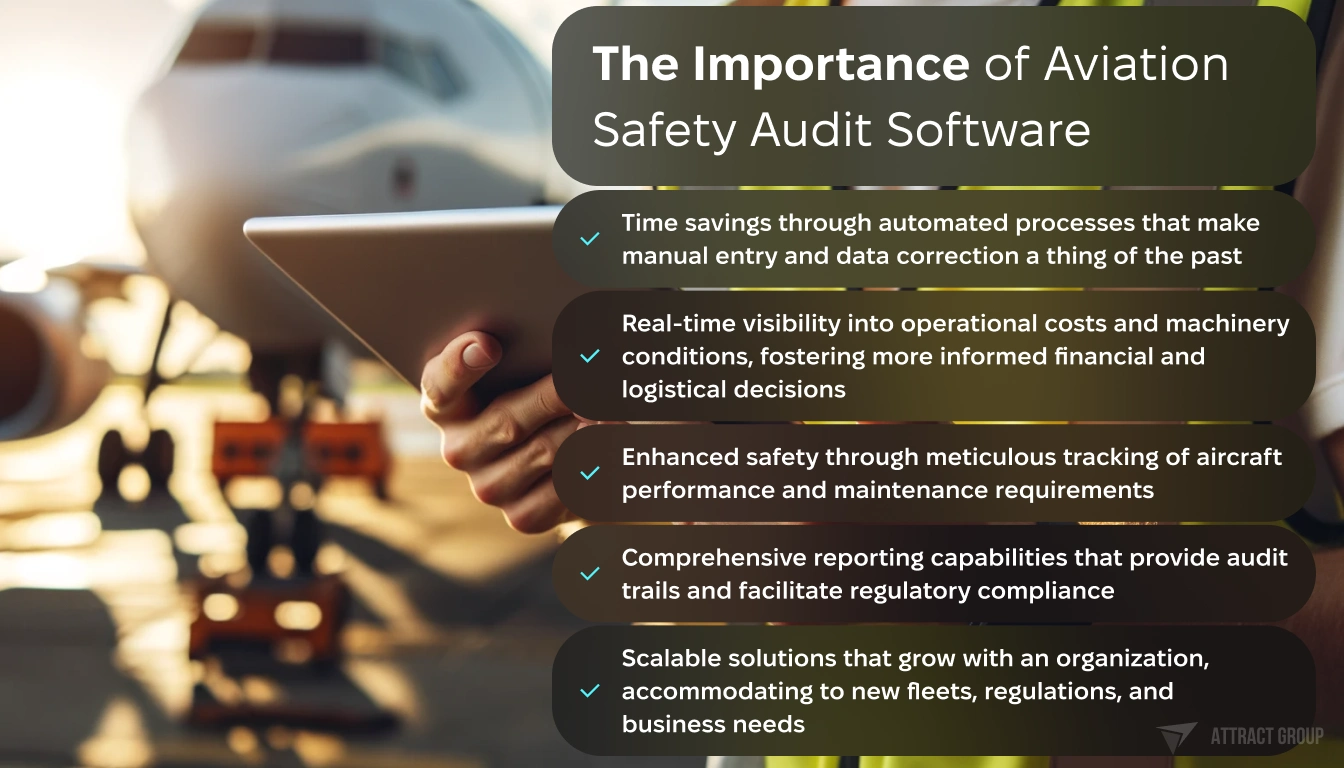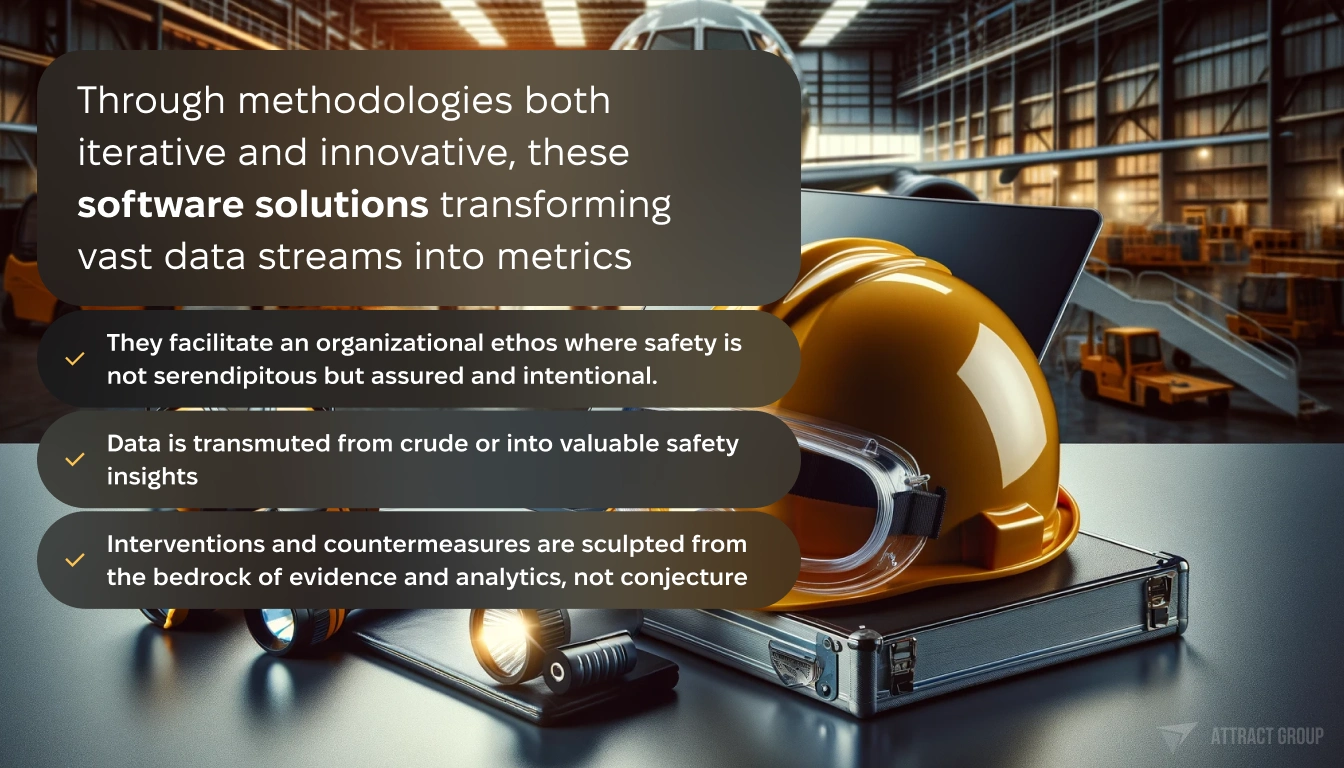Advancements in Aviation Safety Audit Software Development
 11 January 2024
11 January 2024? Listen to the Summary of this article in Audio
The landscape of aviation safety is constantly transforming, as leaders in the field innovate with robust aviation safety audit software development. At the forefront of this innovation is GE Digital’s Safety Insight software, designed with the precise needs of the aviation industry in mind. It embodies the pinnacle of aviation industry compliance software, setting new benchmarks for accuracy in data analysis to minimize false signals and enhance flight safety.
As an ever-evolving domain, aviation software development seamlessly integrates cutting-edge technological solutions with operational efficiency, transforming the role of safety audits from reactive checks to proactive risk management instruments. Through sophisticated solutions including Safety Insight for Airlines and Safety Insight for Business Jets, GE Digital exemplifies a commitment to excellence and industry leadership in the aviation sector.
Key Takeaways
- GE Digital’s Safety Insight software is setting industry standards in aviation safety audit software development.
- Accurate data analytics are key to reducing false positives and enhancing flight safety.
- Aviation software development provides automated solutions that streamline operational efficiency while adhering to compliance standards.
- Customized Safety Insight solutions for different scales of operations ensure optimal performance and risk management.
- Partnerships and integrations within the industry play a critical role in advancing the capabilities of compliance software.
- Proactive risk management through aviation software furthers the evolution from reactive safety measures to preventive strategies.
- The focus of aviation software is moving towards predictive analytics and maximizing safety in real-time operations.
Our aviation technology experts can develop customized safety audit software tailored to your fleet’s unique needs.
The Importance of Aviation Safety Audit Software
The imperative to maintain and enhance operational safety in the aviation industry has never been more pronounced. As the sector grows, so does the complexity of its operational logistics, fueling the demand for sophisticated aviation safety audit software. This digital infrastructure plays an essential role not only in streamlining administrative tasks but also in predicting and averting potential risks. Utilizing an aircraft safety audit tool represents the industry’s shift towards a more proactive and data-driven approach to uphold the highest safety standards.

Key operational processes, including maintenance scheduling, repair management, and resource allocation, are handled with increased accuracy and efficiency. By leveraging the power of technology to automate these critical tasks, aviation organizations can focus on more strategic safety initiatives. Therein lies the core value proposition of aviation safety audit software: the transformation of raw operational data into insightful, actionable intelligence.
In today’s era, where data is king, the ability of this software to analyze vast quantities of information is invaluable. By understanding patterns, predicting maintenance needs, and ensuring compliance through the auditing process, software tools are crucial for organizations striving to achieve exceptional safety standards and operational excellence.
“The efficiency and insights gained from advanced aviation safety audit tools are unparalleled in preserving the integrity of our operations and ensuring passenger safety.”
Further substantiating the efficacy of aviation safety audit software are the following benefits:
- Time savings through automated processes that make manual entry and data correction a thing of the past.
- Real-time visibility into operational costs and machinery conditions, fostering more informed financial and logistical decisions.
- Enhanced safety through meticulous tracking of aircraft performance and maintenance requirements.
- Comprehensive reporting capabilities that provide audit trails and facilitate regulatory compliance.
- Scalable solutions that grow with an organization, accommodating to new fleets, regulations, and business needs.
The following table offers a snapshot of the various functions and advantages provided by leading aviation safety audit software, emphasizing their transformative impact on the industry:
| Function | Benefit | Result |
|---|---|---|
| Maintenance Automation | Reduces downtime, increases aircraft availability | More flight hours and improved reliability |
| Compliance Tracking | Ensures adherence to safety regulations | Fewer breaches, less risk of penalties |
| Real-Time Data Analysis | Instant access to operational insights | Proactive risk management, enhanced decision-making |
| Resource Optimization | Efficient use of crew and inventory | Cost savings, reduced resource wastage |
| Flight Data Monitoring | Continuous performance assessment | Higher safety standards, informed training protocols |
The move towards integrating aviation safety audit software into the operational fabric of aviation businesses is a testament to the field’s evolution. Such integration is an unequivocal step towards a safer, more reliable, and efficient future for aviation, where technology serves as the backbone of continuous improvement in safety management.
Essentials of Aviation Safety Management Systems
In the high-stakes realm of aviation, ensuring the utmost in safety is paramount. An effective aviation safety management system (SMS) serves as the backbone of a comprehensive safety program, integrating advanced technologies and methodologies to maintain, manage, and improve safety standards within an organization. These systems offer a structured means to control risk and accomplish vital safety objectives through proactive safety strategies.

The proactive approach to risk management that a sophisticated aviation safety management system embodies enables organizations to adapt rapidly to changes within the industry, ensuring safety remains at the forefront of operations. These systems provide an infrastructure for ongoing safety assessments, allowing for real-time responses to events as they occur and facilitating forward-thinking analyses that aim to prevent future incidents.
Particularly noteworthy is the capability of these systems to analyze and digest copious amounts of data, turning them into actionable insights. From flight data monitoring to maintenance tracking, the safety audit reporting system is a critical component in the aviation industry’s quest to achieve safer skies.
Implementing an advanced aviation safety management system equips an organization with the necessary tools to anticipate safety hazards and manage risks effectively, fostering a culture dedicated to safety and proactive risk management.
It is through the comprehensive administration of smart document management, change control processes, and business analytics that industry leaders are able to elevate their safety management practices. Utilizing innovative features such as the bowtie risk module organizations can visually map out complex risk scenarios, clarifying the relationships between possible causes, preventative measures, and recovery strategies. This complex interplay of features effectively translates into higher safety margins and improved operational efficiency.
- Smart, organization-specific forms facilitate personalized safety protocols.
- Document management with change control safeguards the integrity of safety documentation.
- The bowtie risk tool allows for visual analysis and management of safety risks.
- Business analytics provide in-depth insights and forecasts to drive decision-making.
By encompassing these essential components, leading aviation organizations leverage aviation safety management systems to institutionalize a data-driven, proactive safety culture, as indicated in the table below which outlines key elements and their contributions to aviation safety:
| Element | Contributions to Aviation Safety | Impact on SMS |
|---|---|---|
| Proactive Hazard Identification | Anticipates risks, prevents incidents | Enhances real-time risk management |
| Data-Driven Decision Making | Utilizes analytics for informed safety decisions | Improves accuracy and reliability of safety initiatives |
| Incident Reporting and Analysis | Ensures thorough review and follow-up on safety events | Promotes continuous improvement and learning |
| Policy Management | Standardizes safety protocols and practices | Fosters consistency and regulatory compliance |
| Action Management | Tracks and assigns safety actions | Ensures accountability and closure of safety tasks |
As we look at the integration and application of such systems globally, it becomes evident that an aviation safety management system is not merely an option but a necessity for any aviation operation seeking longevity and success. The broad adoption of such systems solidifies a culture that prioritizes safety and embodies a commitment to the highest standards within the aviation industry.
Benefits of Custom Aviation Safety Software Development
The advent of custom aviation safety software solutions is revolutionizing the industry, bringing unprecedented levels of compliance, efficiency, and scalability. These custom-developed tools are crucial for meeting the intricate and stringent demands of aviation safety regulations.
Enhanced Compliance and Regulatory Adherence
Maintaining compliance with ever-changing aviation regulations is a tremendous challenge. Custom aviation industry compliance software ensures that aviation businesses not only meet but also stay ahead of regulatory requirements. This software automates the tracking of legislative changes, thus providing a robust framework for adhering to the latest standards and policies prescribed by aviation authorities.
Custom compliance management software translates into a safety net, guaranteeing that aviation operations do not breach critical regulations that could otherwise lead to serious financial and reputational damage.
Tailored Solutions for Specific Operational Needs
Every aviation operation has a set of unique needs and challenges. Unlike off-the-shelf products, custom aviation safety software development can be meticulously crafted to fit the specific workflows and safety protocols of individual operators. Such precision in design ensures that software features align perfectly with operational realities, enhancing the efficiency and effectiveness of safety audits.
Scalability and Flexibility for Growing Aviation Businesses
As aviation businesses grow, their software systems must also evolve. Scalability is at the core of custom safety software. It accommodates expanding operations, complex data sets, and increased user bases seamlessly. By boasting the adaptability to match growth, custom scalable safety audit software enables aviation businesses to continue their trajectory while maintaining the highest safety oversight standards without compromise.
- Ensures that growing data volumes do not outpace audit capabilities
- Adjusts to the integration of new aircraft and technologies within the fleet
- Supports expansion into new markets with localized safety procedures
To summarize the benefits of custom safety software, a detailed table reflects specific areas where custom solutions dramatically surpass one-size-fits-all software:
| Benefit | Impact on Aviation Safety |
|---|---|
| Enhanced Regulatory Compliance | Reduces the risk of non-compliance and associated penalties |
| Customizable to Operational Demands | Increases safety audit accuracy and relevance |
| Scalable as Operations Grow | Provides long-term reliability and consistency in safety management practices |
For aviation businesses contemplating the next step in safety management, investing in custom safety software development is key. It not only brings tailored solutions that meet specific operational demands and enhance regulatory compliance but also offers the scalability necessary for adapting to the dynamic aviation landscape. With these bespoke tools, aviation operations can bolster their safety protocols, ensuring they remain resilient and responsive to the demands of 21st-century air travel.

Key Features of Aviation Safety Audit Reporting Systems
Within the aviation industry, the deployment of an effective safety audit reporting system is crucial for monitoring compliance and assuring safe operations. These sophisticated systems possess a suite of key features designed to maximize efficiency, enhance accuracy, and support the overarching goal of incident prevention. Among them, the provision of clean and precise data is one of the most critical, as it underpins every analysis and insight that the aviation safety audit software delivers.
Leading systems are characterized by their ability to track and monitor safety performance meticulously. Data cleansing and processing by experts are cornerstones of these platforms, contributing to the high quality of data that is integral for conducting reliable and effective safety audits. The role of analytical capabilities cannot be understated; they transform vast quantities of raw flight data into meaningful metrics and actionable intelligence.
The combination of these features allows for active participation in industry studies and peer-to-peer exchanges of safety best practices. It also fosters the ability to tailor safety practices and training programs, giving organizations the tools to customize their approaches based on the unique insights gleaned from safety event data analysis.
Through aviation safety audit software, businesses can control the flow of data within their organizations, optimizing safety practices and facilitating informed decision-making that leads to a reduced number of safety events and a heightened sense of operational security.
Highlighted below is a comparative table outlining the essential features of an advanced safety audit reporting system and their respective impacts on organizational safety protocols.
| Feature | Purpose | Impact on Safety Audit Reporting |
|---|---|---|
| Automated Data Ingestion | Streamlines the data collection process | Ensures timely and comprehensive data availability for audits |
| Data Cleansing and Processing | Improves data quality for analysis | Enhances the accuracy and credibility of safety reports |
| Analytical Tools | Extracts insights from complex data sets | Enables proactive risk assessment and management |
| Risk Assessment Tools | Identifies potential hazards and risks | Facilitates the development of risk mitigation strategies |
| Alerts for Relevant Information | Notifies of critical events or compliance deviations | Allows immediate corrective actions and continuous monitoring |
| Customization Capabilities | Tailors the system to specific organizational needs | Ensures relevancy and applicability of the safety audit processes |
| Industry Compliance Features | Tracks and ensures adherence to standards and regulations | Minimizes legal and financial risks associated with non-compliance |
An exhaustive approach to safety, propelled by these innovative features, positions aviation organizations to not only react appropriately to incidents but, more importantly, to anticipate and prevent potential safety issues before they arise. As the demands of the aviation industry continue to evolve, so too does the technology driving these safety audit reporting systems, ensuring sustained adherence to the paramount priority of flight safety.

How Aviation Compliance Management Software Supports Safety Protocols
The interplay between aviation compliance management software and the embedded safety standards within aviation operations is an essential aspect in the continuous drive to improve safety protocols. With a growing emphasis on minimizing error and reinforcing risk management strategies, software solutions play a pivotal role in enhancing and supporting safety procedures in the aviation sector.
Automation of Safety Procedures
Automation stands at the heart of modern aviation compliance management software, shifting the focus from manual, error-prone processes to reliable, streamlined operations. Automated safety procedures provide an effective tool to ensure regulatory adherence while granting aviation personnel the bandwidth to concentrate on strategy and analysis rather than routine tasks.
Automation in aviation facilitates a consistency in practice and responsiveness that is unmatched by manual processes, significantly advancing the reliability of safety protocols.
Real-Time Data Analysis for Proactive Safety Measures
Equipped with capabilities for real-time data analysis, aviation safety management systems empower operators with the insights to preemptively troubleshoot potential hazards. The immediate availability of this real-time information is the cornerstone of implementing proactive safety measures and fostering an agile and safety-oriented culture within aviation businesses.
In essence, these software systems serve as the critical operational pivot where data meets decision-making, a nexus that underscores the importance of number 7 – proactive measures – in aviation compliance and safety. Offering a detailed view of trends and risks, these tools help managers to not only react to existing situations but also anticipate and mitigate future safety events.
The following table illustrates the advantages of integrating aviation compliance management software into safety protocols:
| Benefit | Description | Impact on Safety Protocols |
|---|---|---|
| Consistent Compliance | Automation ensures adherence to regulatory standards | Reduces risk of non-compliant incidents |
| Error Reduction | Decrease in manual entry related mistakes | Improves overall safety and accuracy of data |
| Enhanced Productivity | Automated processes free up time for safety staff | Allows focus on strategy and risk management |
| Proactive Safety Insights | Real-time data provides actionable intelligence | Enables the prediction and prevention of potential hazards |
As the aviation industry continues to advance, the role of comprehensive compliance software becomes ever more integral in establishing and maintaining an environment where safety protocols are not just followed but are enhanced through technological innovation. By automating critical procedures and leveraging the power of real-time data, these systems embody the evolving nature of aviation safety management, which consistently aims for the pinnacle of operational excellence and passenger security.
Aviation Safety Software Solutions and Risk Management
The critical role of aviation safety software solutions is more evident today than ever in the ecosystem of risk management in aviation. These solutions are not just technical tools—they are the vanguard in the mission to ensure the skies remain a frontier of safety and reliability. Our discussion today homes in on the inextricable link between these software offerings and the praxis of risk management, delineating how the stratagem of technology sustains and enhances the tapestry of flight safety.

At the heart of the discourse is a premise: aviation safety software solutions are essentially the lens through which the aviation industry scrutinizes the anatomy of risk. These comprehensive solutions beget a duality of action—both curative and preventative—that formulates the bulwark against unwarranted safety events in aerospace operations.
The systems in place not merely record; they decipher and chronicle flight data into comprehensive reports. These documents then become the scroll from where changes are scripted — altering protocols, modifying training, and heightening awareness — all with the intent of documenting and then diminishing safety events. It’s a continually refining cycle, informed and driven by these agile software systems, fostering a dynamic where safety and vigilance coalesce into a singular pursuit.
“Effective risk management in aviation hinges upon the synergy between vigilant human oversight and the predictive accuracy of safety software solutions. This confluence makes for an indomitable alliance in safeguarding our skies.”
Through methodologies both iterative and innovative, these software solutions paint a clear portrait of safety, transforming vast data streams into metrics that can be acted upon. As these metrics are scrutinized, patterns emerge—signals amid the noise pointing to potential improvements, training needs, or even policy adjustments.
- They facilitate an organizational ethos where safety is not serendipitous but assured and intentional.
- Data is transmuted from crude or into valuable safety insights.
- Interventions and countermeasures are sculpted from the bedrock of evidence and analytics, not conjecture.
The ultimate aim is not to be unerringly reactive but steadfastly proactive. Not to chase safety like a horizon forever elusive, but to engineer an environment where safety is an inherent attribute, woven into the very fabric of operational routine. This strategic orientation of safety is achieved through the prism of software solutions—software that is painstakingly designed to be nimbly responsive and steadfastly reliable within the dynamic and demanding sphere of aviation operations.
| Software Feature | Operational Impact | Risk Management Facilitation |
|---|---|---|
| Flight Data Analysis | Identifies and flags risk patterns | Enables informed policy development and training programs |
| Safety Trend Tracking | Monitors changes over time | Establishes a foundation for predictive risk modeling |
| Customizable Alert Systems | Notifies teams of critical issues | Allows rapid deployment of safety measures |
| Regulatory Compliance Reports | Ensures adherence to industry standards | Safeguards against non-compliance and the associated risks |
This tapestry woven from the threads of data, software, and human ingenuity stands as a testament to the realm of possibility—where safety is not just imagined but instantiated and where the risk is not just an adversary but a well-understood and mastered element of aviation’s broader narrative.

Integrating Aircraft Safety Audit Tools with IoT and Big Data
The aviation industry is embarking on a significant transformational journey as aircraft safety audit tools synergize with the Internet of Things (IoT) and Big Data analytics. This innovative integration is reshaping how aviation safety is approached, providing a critical leap towards proactive safety measures and efficiency in operations. As a result, aircraft are not just vehicles but data hubs, streaming information that, when interpreted through advanced analytics, offer groundbreaking predictive safety analytics.
Leveraging Data for Predictive Safety Analytics
Within the framework of IoT in aviation safety, connected devices and sensors onboard aircraft and at airports collect an immense variety of data. This data, encompassing everything from engine performance to flight patterns, is a potential goldmine for enhancing safety protocols. By utilizing predictive safety analytics, aviation professionals can now anticipate issues that could lead to incidents and implement preventive measures in advance. This forward-thinking approach underlines a shift from reactive to anticipatory safety strategies within the sector.
Predictive analytics in aviation safety are setting new standards in risk management, driving not just reactive responses to issues but also preemptive measures that can avert potential safety breaches entirely.
A table that demonstrates the impact of integrating IoT and Big Data with aircraft safety audit tools can underline the move towards a more informed and predictive approach in aviation safety:
| Integration Area | Benefits | Preventive Actions Enabled |
|---|---|---|
| Engine Performance Data | Early detection of anomalies | Schedule maintenance before failures occur |
| Flight Operation Patterns | Identifying suboptimal practices | Adjust training and update procedures for safety |
| Environmental Data | Weather and terrain analysis | Optimize flight routes and times to avoid risk |
| Aircraft Health Monitoring | Continuous assessment of aircraft condition | Preemptive rectification of technical issues |
While the process of integrating these complex systems poses its challenges, the vision of a technologically fortified aviation industry is becoming increasingly attainable. Aviation organizations employing this kind of risk analysis are consistently performing at higher levels of safety and operational effectiveness.
- IoT devices facilitate the real-time gathering of safety-critical data.
- Big Data platforms provide the storage and computing power needed to process large volumes of information.
- Data scientists and aviation safety experts collaborate to refine predictive models.
- Advanced analytics offer insights that enable proactive safety management.
IoT and Big Data are not future aspirations but current realities changing the landscape of aviation safety. By harnessing their capabilities, aircraft safety audit tools become more than just compliance trackers; they emerge as indispensable assets in the meticulous orchestration of aviation safety.
This integration is indeed a bellwether of a new era—an era where the multitude of data, once silent, now speaks volumes, and the projections made are not of fear but of readiness and control. As the aviation industry continues to evolve, the embrace of IoT, Big Data, and predictive analytics is showing that the sky is not the limit when it comes to enhancing safety and efficiency.

Case Study: Success Stories in Aviation Safety Software Implementation
Aviation safety software implementation has steadily become a cornerstone in the quest for advanced safety and efficiency within the sector. A deep dive into recent case studies reveals an array of aviation software success stories that highlight the pivotal role such software plays in transforming safety culture and enhancing risk management procedures.
The partnership between Gulfstream and GE Digital serves as a prime example. The introduction of the Gulfstream FORMS program, seamlessly integrated into the C-FOQA Centerline, illustrates how tailored aviation safety software can drive substantial improvements in operational safety outcomes. Gulfstream’s proactive engagement with GE ensures ongoing enhancement of data integrity, essentially refining the safety analysis provided to operators.
Through the utilization of dedicated aviation safety software, Gulfstream has demonstrated enhanced monitoring and reporting capabilities, setting a new precedent in the industry for safety compliance and efficient data analysis.
Further amplifying the impact of safety software in aviation is the collaboration between Polaris Aero and GE Digital. Polaris Aero has led the charge in risk analysis and safety management, integrating its VOCUS SMS with GE’s C-FOQA to create a synergistic relationship between flight data and safety management systems. This partnership underscores the value of leveraging application programming interfaces (APIs) to expand the breadth and depth of safety analysis.
| Company | Software Utilization | Operational Improvement |
|---|---|---|
| Gulfstream | C-FOQA Centerline integration with FORMS | Enhanced data monitoring, safety compliance |
| Polaris Aero | VOCUS SMS integration with GE’s C-FOQA | Synergy between flight data and safety systems |
Both Gulfstream’s and Polaris Aero’s narratives elevate the discussion surrounding aviation safety software to tangibly showcase its integral role in improving flight safety, reducing risks, and enhancing the overall efficacy of aviation operations.
- Gulfstream’s adoption of advanced safety analysis software demonstrates a commitment to continuous safety improvement for operators.
- Polaris Aero’s integration highlights the increasing intersections between technology and safety management, illustrating how this convergence is realized in the industry.
These aviation software success stories provide not just validation for current adoption but also reinforce the need for continued investment and integration of cutting-edge safety technologies within aviation operations. They stand testament to the potent improvements made possible through the strategic implementation of data-driven safety solutions. The future of aviation safety is inseparably linked with the advancement of such empowering software tools.

Aviation safety software implementation echoes a narrative of success, capturing the remarkable strides made within the industry and serving as benchmarks for emerging aviation enterprises worldwide.
Leverage custom aviation software to enhance data analysis, risk mitigation, and training like industry leaders.
Future Trends in Aviation Safety Technology
As we witness the dawning of a new era in aviation, the horizons of aviation safety technology are expanding with the promise of innovations that aim to enhance operational safety and efficiency. Significant strides are being made in the field, with trends signifying a shift towards more predictive, intelligent safety systems. Here, we explore the foreseeable future aviation safety trends poised to redefine industry standards.
Emerging trends in aviation safety technology are the harbingers of a new age in flight operations, driven by data intelligence and comprehensive risk management strategies.
The infusion of the Internet of Things (IoT) and Big Data within aviation is advancing predictive analytics, deepening the safety knowledge well beyond its current state. This confluence of technology is enabling an end-to-end safety view, anticipating risks before they transpire. With Big Data’s analytical might and IoT’s connected sensors, we’re entering a phase where almost every aspect of flight operations can be monitored and managed in real-time.
In line with this advancement is the rise of more intricate risk assessment systems which are slated to become far more advanced than their predecessors. These systems aim to identify and evaluate potential threats with greater precision, facilitating prompt and effective decision-making.

Fostering this evolution are scalable and user-friendly safety management platforms that allow for more proactive safety measures. These platforms are being designed to be accessible, ensuring that the best in safety practices can be implemented regardless of the size or scale of the operation.
Parallel to technological shifts, a cultural trend is taking shape within aviation’s professional community. There is a growing recognition of the need for greater diversity, particularly gender diversity, in the workforce. The pursuit of this goal is crucial, not only for enhancing the industry’s competitiveness but also for broadening the perspectives required to drive innovation.
With these technological advancements and cultural shifts, the aviation industry is on the precipice of a significant transformation. But what does the fusion of IoT, Big Data, and a focus on diversity mean in practical terms for aviation? A vibrant picture is painted through the comparative insights laid out in the table below.
| Trend | Benefits | Practical Implications |
|---|---|---|
| IoT and Big Data Integration | Enhanced predictive analytics and real-time safety monitoring | All-encompassing operational oversight, leading to improved response times and incident prevention |
| Advanced Risk Assessment Systems | Increased accuracy in threat detection and risk evaluation | More targeted safety measures and refined safety protocol development |
| User-Friendly Safety Platforms | Better accessibility and adaptability in safety management | Broadened implementation of safety practices across various scales of aviation operations |
| Emphasis on Diversity | Wider talent pool and innovative perspectives | Enhanced problem-solving skills and competitive edge in safety solution development |
The tremors of change are palpable across the industry as the drive for a safer future gains momentum. These advancements in aviation safety technology and the push for more inclusive talent recruitment are indefinitely shaping the future of aviation. By turning the lens towards these promising trends, the industry is fundamentally bolstering its commitment to achieving unparalleled levels of safety and operational excellence.
Work with our team to integrate the latest IoT, predictive analytics, and risk management platforms.
Choosing the Right Partner for Aviation Software Development
When entering the arena of aviation safety and compliance, the significance of selecting an aviation software development partner cannot be overstated. The intricate nature of the aviation sector, with its multifaceted regulations and operational complexities, demands a partner with profound aviation industry software expertise. Such proficiency is indispensable for creating safety audit platforms that not only meet but exceed the multifaceted demands of contemporary airspace navigation and safety assurance.
Expertise in the Aviation Industry
An ideal partner embodies a deep-rooted understanding of aviation-specific challenges such as regulatory adherence, data integrity, and risk management strategies. This industry expertise empowers a software development partner to discern the nuances of aviation operations, thereby crafting software solutions that deliver tangible benefits and drive operational excellence.
Moreover, partners equipped with comprehensive aviation knowledge can adeptly maneuver through the complexities of software development within this sphere, guaranteeing that the end-product is both robust and regulatory-compliant. They also play a pivotal role in ensuring that software deployments align seamlessly with existing systems and enhance the overall efficacy of safety management.
Track Record in Delivering Robust Safety Audit Platforms
A partner’s legacy in safety audit platforms development speaks volumes about their ability to meet the rigorous demands of the aviation sector. A robust track record showcases the potential to handle intricate project requirements and to provide high-quality, dependable safety solutions that are well-aligned with global regulatory standards.
Aviation companies with a history of successful deployments instill confidence and establish credibility by demonstrating their preparedness to tackle the diverse challenges associated with aviation safety software projects. From concept to launch, these partners should exhibit a steadfast commitment to quality and customer satisfaction.
A history of success in developing safety audit platforms is not just about past accomplishments, it is a promise of future reliability and innovation in aviation software development.
A prospective development partner should be assessed based on a set of criteria that reflects their capabilities and suitability for your specific needs. The table below illustrates the essential factors to consider when selecting the right aviation software development partner:
| Criteria | Importance | Evaluation |
|---|---|---|
| Industry Expertise | Critical | Look for evidence of deep industry knowledge and the ability to navigate its unique challenges. |
| Technological Proficiency | Vital | Assess their mastery in modern software technologies and frameworks important for aviation solutions. |
| Regulatory Understanding | Essential | Ensure they have a proven track record in creating software that adheres to aviation regulations. |
| Past Success | Indicative | Review case studies or testimonials from previous clients to understand their delivery success rate. |
| Innovation and R&D | Forward-Looking | Gauge their commitment to research and innovation in tackling emerging aviation safety threats. |
Committing to a partnership with a development company that possesses Target 12 of the excellence characteristics is an investment in your organization’s future. Such a firm not only brings immediate solutions to your present challenges but also paves the way for your evolution within the rapidly advancing domain of aviation safety and compliance.

In closing, your choice of an aviation software development partner is a strategic decision that will reverberate through your safety audit processes, compliance posturing, and overall operational resilience. It’s a decision that should be guided by meticulous consideration of a partner’s industry acumen, a proven record of success in delivering cutting-edge technology, and a harmonized vision for driving advancements in aviation safety.
Conclusion
In the realm of advanced aviation operations, the role of aviation safety audit software has become indispensable. Embracing the wealth of capabilities offered by robust systems such as those by GE Digital, the industry has made significant strides in safety and operational efficiency. The deployment of sophisticated aviation safety management systems has been pivotal, enabling organizations to not only monitor and analyze data in real-time but also adopt a more forward-thinking approach to managing potential risks.
The integration of IoT and Big Data has further propelled these systems to the forefront of predictive analytics, illustrating a future where risk management is informed by real-time intelligence. The success of such technological integrations has been underscored by impactful case studies, where the strategic implementation of safety audit software has dramatically uplifted the safety protocols and risk management procedures of leading aviation players.
As we gaze into the horizons of aviation’s future, the importance of choosing the right software development partner emerges as a keystone decision. It’s a choice that carries immense implications for an aviation organization’s ability to maintain and elevate safety standards and operational excellence. Thus, selecting a partner well-versed in aviation’s unique demands, with a proven track record and a steadfast commitment to innovation, is vital. It’s through this synergy between sophisticated aviation safety audit software and adept partners that the industry will continue to soar to new heights of safety and efficiency.
Our experts are ready to develop integrated, aviation-specialized software solutions.
FAQ
What is aviation safety audit software development?
Aviation safety audit software development involves creating specialized programs designed to inspect and ensure compliance with aviation safety standards. It focuses on risk management, data analytics, and process automation, aiming to improve flight safety and operational efficiency within the aviation industry.
How does aviation safety audit software support the aviation industry?
The software automates manual safety audit processes, streamlines safety management practices, enables real-time risk assessments, and ensures compliance with aviation regulations. By doing so, it enhances overall flight safety and optimizes the maintenance and operational procedures of aviation entities.
What are the benefits of a custom aviation safety management system?
Custom aviation safety management systems offer tailored solutions designed to meet the specific operational needs of an organization. They enhance regulatory compliance, and enable scalability for growing aviation businesses. These systems are more efficient and effective in managing safety audits, incidents, and risk analysis specific to the company’s procedures.
What does aviation safety audit software typically include?
Aviation safety audit software includes tools for tracking safety performance, managing data flow, optimizing safety practices, and facilitating industry compliance. They can also feature modules for incident reporting, risk assessment, policy management, and real-time data analysis for proactive safety management.
How does aviation compliance management software enhance safety protocols?
Aviation compliance management software automates critical safety procedures, such as data ingestion, error correction, and compliance checks, thus reducing the potential for human error. It supports real-time data analysis, helping organizations to respond quickly to emerging risks and to maintain high safety standards consistently.
What role does aviation safety software play in risk management?
Aviation safety software plays a critical role in risk management by providing tools for meticulous risk assessment and management associated with flight operations. It helps in analyzing data to shape safety policies, adjust training, and enhance crew awareness, aiming to reduce safety events and improve risk management practices.
How are aircraft safety audit tools integrating with IoT and Big Data?
Aircraft safety audit tools are becoming more sophisticated through integration with IoT and Big Data, which allows for harnessing extensive data for predictive analytics. This integration enables aviation organizations to anticipate safety issues and take proactive measures to enhance safety and efficiency.
Can you provide examples of success stories in aviation safety software implementation?
Success stories in aviation safety software implementation include partnerships and programs such as Gulfstream’s FORMS program within the C-FOQA initiative, and collaborations with companies like Polaris Aero. These examples highlight how integrating safety software improves safety outcomes and operational efficiency within aviation organizations.
What are the future trends we can expect in aviation safety technology?
Future trends in aviation safety technology include further integration of IoT and Big Data for improved predictive analytics, advancements in risk assessment systems, and the development of scalable, user-friendly platforms designed for proactive safety management. Additionally, the inclusion of greater workforce diversity and talent attraction is anticipated to drive industry growth and innovation.
Why is choosing the right aviation software development partner important?
Selecting the right aviation software development partner is crucial because it ensures that the software is developed by experts who understand the specific challenges and requirements of the aviation industry. Partners with a proven track record can deliver high-quality, reliable safety solutions tailored to an organization’s needs while ensuring compliance with regulatory standards.









